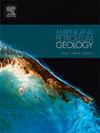中国南海北部大陆边缘重要高幅磁异常带的成因来源
IF 3.7
2区 地球科学
Q1 GEOSCIENCES, MULTIDISCIPLINARY
引用次数: 0
摘要
磁异常图显示,南海北部大陆边缘有一个明显的东北-西南走向的高幅磁异常带(NSCSMA),从台湾西南部一直延伸到大约东经114°和北纬20°的区域。这一高振幅磁异常带的起源对于了解岩浆活动、大陆边缘断裂和南中国海的构造演化非常重要。为了深入了解这一问题,本研究采用了小波频谱分析、二维磁场建模和紧凑反演等方法来确定南中国海磁异常区的成因源。结合小波频谱分析和磁场建模结果,我们发现主要磁源的深度在南中国海马里亚纳海区的走向上并不一致(东部为 15 千米,西部为 25 千米)。同时,我们对横跨南亚大陆架的五个剖面进行的紧凑反演结果显示,南亚大陆架的成因源具有两种不同深度的几何形态(东部为类堤状、西部为圆顶状)。根据我们的研究结果和先前的古俯冲模型,我们提出了南大西洋海底山脉的主要成因是与古太平洋板块俯冲有关的蛇化上地幔物质。本文章由计算机程序翻译,如有差异,请以英文原文为准。
Causal sources of the significant high-amplitude magnetic anomaly zone in the northern south China Sea continental margin
The magnetic anomaly map shows an obvious NE-SW trending high-amplitude magnetic anomaly zone (NSCSMA) in the northern South China Sea (SCS) continental margin that extends from southwest Taiwan to the area at approximately 114°E and 20°N. The origin of this high-amplitude magnetic anomaly zone is important for understanding the magmatism, margin rifting, and tectonic evolution of the SCS. To gain insight into this issue, in this study, wavelet spectrum analysis, 2D magnetic modeling, and compact inversion were used to identify the causal source of the NSCSMA. Combining wavelet spectrum analysis with magnetic modeling results, we find that the depths of the major magnetic sources are not consistent along the strike of the NSCSMA (∼15 km in the east and ∼25 km in the west). The compact inversion results along five profiles across the NSCSMA also revealed two kinds of geometries (quasi-dike in the east and dome-like in the west) of the causal sources of the NSCSMA with different depths. Based on our findings and previous paleo-subduction model, we propose that the major source of the NSCSMA is serpentinized upper mantle materials associated with paleo-Pacific plate subduction.
求助全文
通过发布文献求助,成功后即可免费获取论文全文。
去求助
来源期刊

Marine and Petroleum Geology
地学-地球科学综合
CiteScore
8.80
自引率
14.30%
发文量
475
审稿时长
63 days
期刊介绍:
Marine and Petroleum Geology is the pre-eminent international forum for the exchange of multidisciplinary concepts, interpretations and techniques for all concerned with marine and petroleum geology in industry, government and academia. Rapid bimonthly publication allows early communications of papers or short communications to the geoscience community.
Marine and Petroleum Geology is essential reading for geologists, geophysicists and explorationists in industry, government and academia working in the following areas: marine geology; basin analysis and evaluation; organic geochemistry; reserve/resource estimation; seismic stratigraphy; thermal models of basic evolution; sedimentary geology; continental margins; geophysical interpretation; structural geology/tectonics; formation evaluation techniques; well logging.
 求助内容:
求助内容: 应助结果提醒方式:
应助结果提醒方式:


